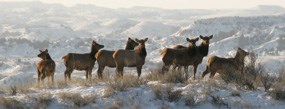
NPS / Nathan King Elk are a large member of the deer family with thick necks, long, thin legs, and a conspicuous light-colored rump patch. They are often found in herds, which allows them to watch for danger. An elk's preferred habitat in the park is open shrubland and grasslands interspersed with hardwood draws and juniper slopes. Elk are herbivorous and their diets include grasses, forbs, and shrubby plants. They are most active at dawn and dusk. Their daily routine typically includes feeding on open butte-tops or valley-bottoms during dawn before retreating to shaded hillsides (typically within juniper thickets) for thermal refuge and cover while they digest their morning meal. Once the sun is close to setting, they will emerge from the hillsides to feed again. History of Elk in the Park Elk were numerous throughout much of the United States, but pressure from over-hunting and human development forced them from much of their former range. Once native to the Badlands of North Dakota, elk were extirpated from the region by the late 1800s. Spotting Elk Visitors to the South Unit have an opportunity to see elk. Although they have been sighted in the North Unit, elk are rare in that region. The animals can be challenging to spot, and the key factor is not just where, but when to look. The best time to look for them is at dawn and dusk since they usually remain hidden in wooded areas during much of the day to escape the heat. In the South Unit, one of the most accessible places to spot elk is from Wind Canyon Overlook, scanning the butte tops to the west during sunrise or sunset. |
Last updated: April 7, 2025
